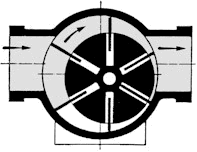<BR> Fig. 3.11: Op. diagram of rotary vane compressor
Fig. 3.11: Op. diagram of rotary vane compressor | When the rotor reaches a certain speed, the working slide is pressed outwards against the inner walls of the housing by centrifugal force. The compression chamber between the rotor and the housing is divided by slides into individual cells ( work chambers).
As a result of the eccentric arrangement of the rotor, the volume increases or decreases during a rotation.
The pressure chambers are lubricated by loss lubrication or oil injection.
By injecting larger quantities of oil into the compression chamber one achieves, in addition to lubrication, a cooling effect and a sealing of the slides against the inner wall of the housing. The injected oil can be separated from the compound of oil and air after compression and directed back to the oil circuit.
Features:
- Pulse-free and even output of air.
- Low space requirement and easy to service.
- High maintenance costs due to wear on the slides.
|